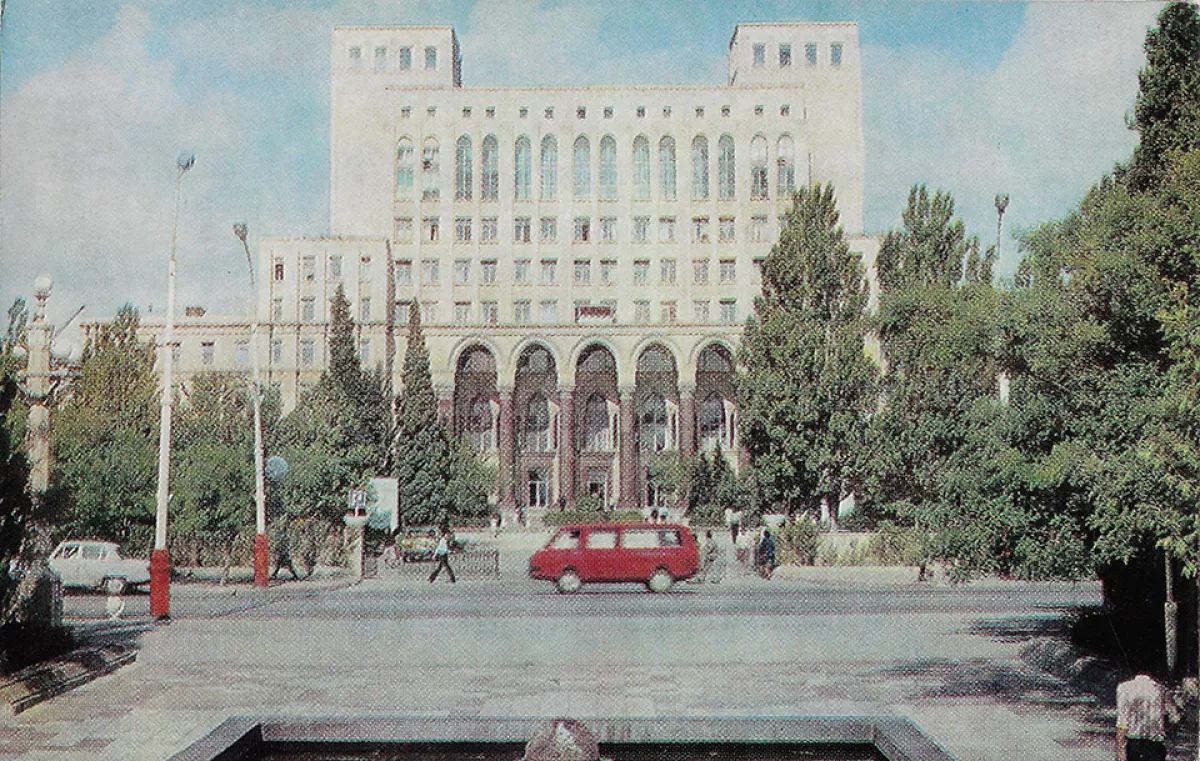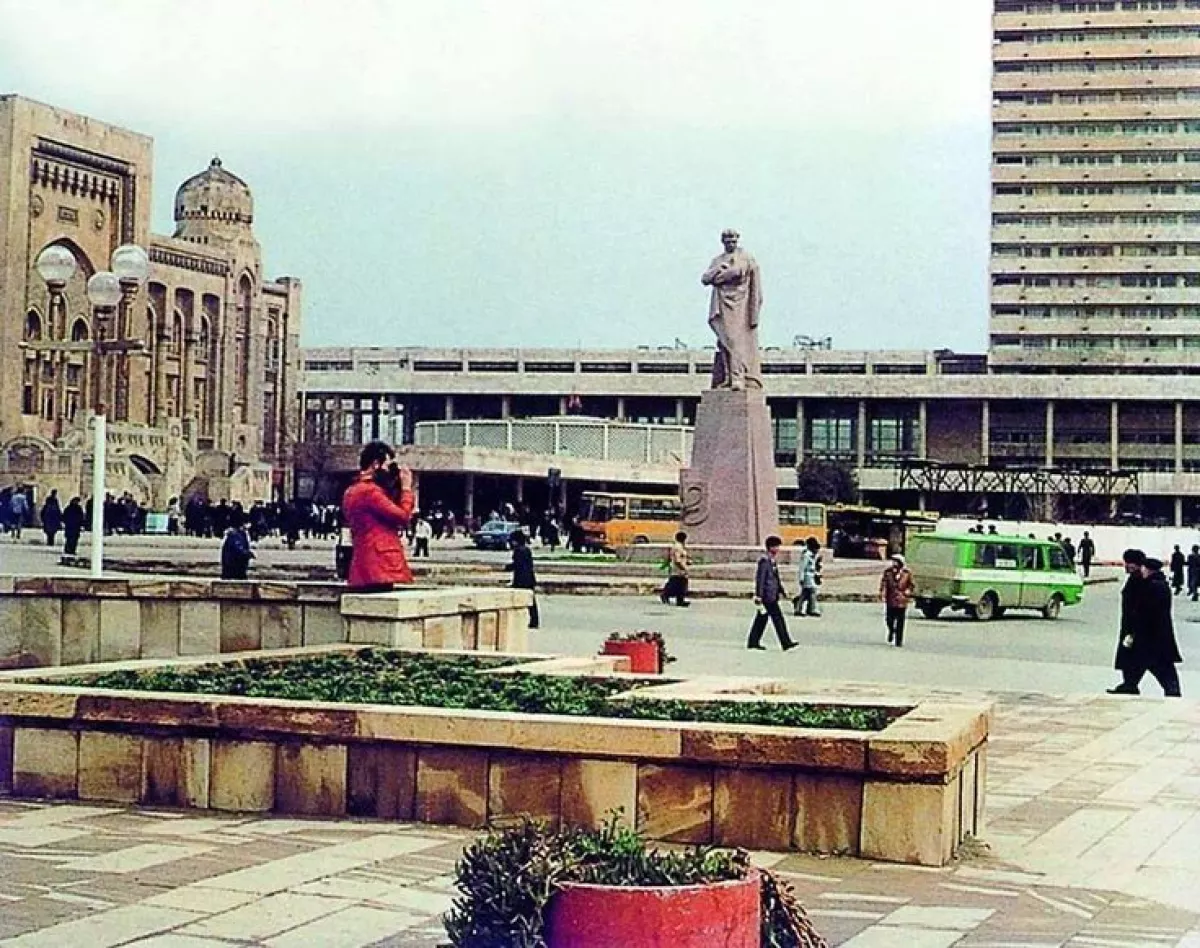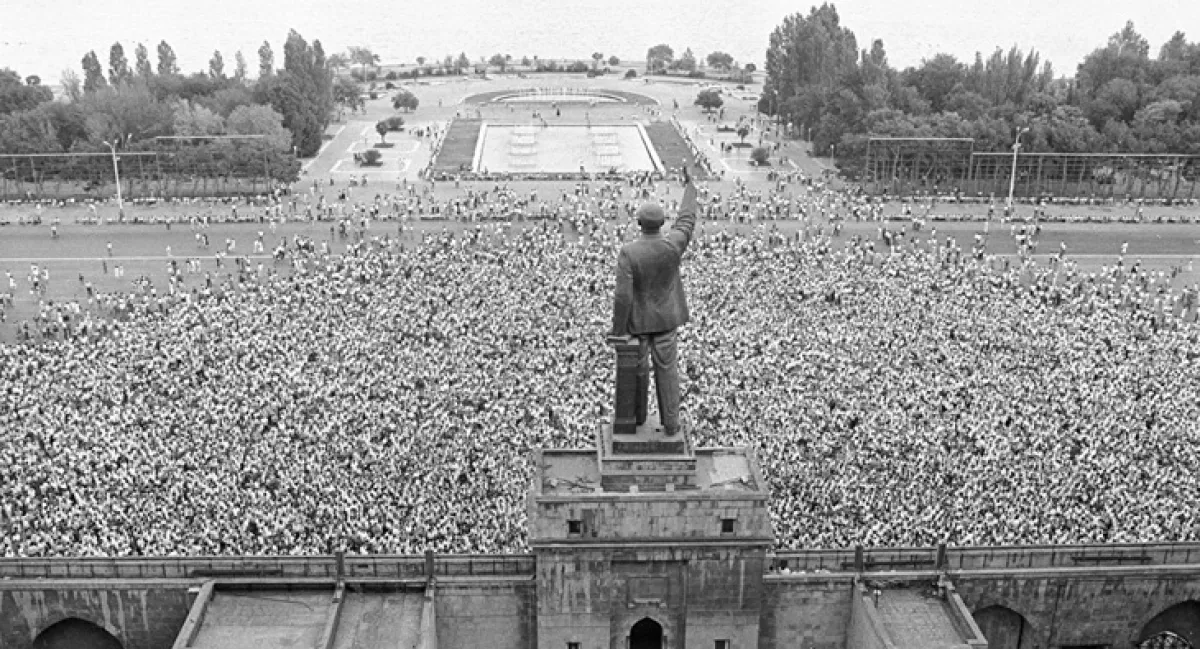Where did the “bright faces” go: double pressure on old Baku Reflections on a city in transition
The years of change from the 1980s to the 2000s were difficult for the middle-tier intelligentsia, which made up a significant part of late-Soviet Baku. Recently, on one of the Azerbaijani forums, its administrator opened a remarkable discussion thread titled “Baku and Baku Residents in 1987 – VIDEO.” “Bright, intelligent faces with the mark of education and culture,” he commented on the video.
Many forum members agreed, recalling the events of those years, their youth, studies, first steps in their careers, romantic relationships, fashionable and scarce clothing of the time, popular music and dances, the city’s operating economic, cultural, and leisure facilities, and the opening of new stations on the “green line” of the metro.
Some were critical, claiming that the cameramen deliberately filmed more photogenic faces, and that for a complete and objective picture, they should have also filmed in other, less prestigious districts of the city.
Someone aptly noted a peculiarity of that year: 1987 became the last year of that calm, measured Baku in which its residents lived: “The last peaceful year,” “Afterwards, more serious adventures began,” “Baku residents unaware of the troubles that awaited them.”

And that is true: in fact, by the end of that same year, the South Caucasus began sinking into the abyss of interethnic conflicts and peoples’ struggles for independence. All of this was accompanied by economic collapse and widespread impoverishment.
I watched the video posted in that thread. It consists of several segments: a teahouse in the city centre, oil workers at the fields, an innovative scientist, students, a deep-water foundations plant, a market, healthcare, a recreational park, youth, believers, and women.
And you know, if one wanted to, it would be possible to find plenty of negativity in any of these segments. Those who lived in late-Soviet Baku remember that often, for any service officially provided for free, you had to “grease the hand” of the person providing it, and that the city, like the entire Soviet Union, faced a shortage of goods. Yet, despite this, many are willing to watch these shots again and again, and the hearts of Baku residents are filled with bright but bittersweet emotions.
The reason for this, I discussed in a similar article I wrote almost four years ago: “On Nostalgia, Total Shortages, and a Period of Great Turbulence.”
The essence of this enduring sadness is that we yearn not so much for the events themselves, but for the feelings we experienced during those events—and these feelings, due to people’s youth at the time, are brighter and more positive from an emotional standpoint.
One forum participant aptly noted that even decades from now, someone will remember the present years with a torn heart: “It’s the year 2070… and suddenly someone digs up an archive and shows what it (Baku – Ed.) was like in 2025.”
But I did not sit down at my laptop to simply quote other people’s opinions from some external media source. So what do I want to say? Clearly, all cities in the world change, and Baku is no exception, just as the turn of the 20th to the 21st century—the period we happened to live through—is no exception. Yes, the capital of Azerbaijan in 1987 and in 2025 is, in fact, almost two different cities. And it’s not just about the buildings—it’s about the people, the population. I think everyone would agree on this, except perhaps the hardened moralists. Some note this process with sadness, lamenting that the city has lost its international “flavour,” its diversity, while others take satisfaction in it, saying that yes, our city has acquired a more national, ethnically appropriate face of an independent state, which it should have.
But here, the discussion is less about the city’s ethnic composition and more about its cultural substance—about what the administrator of that forum wrote, regretting the loss of the city’s “bright, intelligent faces with the mark of education and culture.”
Indeed, Baku’s Soviet-era intelligentsia has a tendency to fade into history. They are gone, never to return. In their place came others—people with different life priorities and social backgrounds.
Let us try to understand what happened from 1988 through the 2010s, and, in essence, what is still ongoing today. And what happened was a series of very interesting and multi-layered events.

The Soviet Union—and, consequently, Azerbaijan as part of it, with Baku as the republic’s capital—found itself during those years caught in several very complex and serious whirlpools, which we will examine. But first, we need to understand what this late-Soviet society was like. It was complex and heterogeneous. There was, among other things, an unspoken division of the Union into the industrial northwest (simply, the North) and the traditional agrarian southeast (for brevity, the South).
It should be understood that national traditions were less preserved in the Slavic republics of the North, while in the Muslim republics of the South, they were strongly maintained. In Russia or Belarus, for example—more urbanised republics—people were even somewhat embarrassed to openly follow national customs, such as music, dance, or traditional dress. In the South, however, people carefully preserved their traditions and remained close to their roots.
As for Western, international, or globalist trends, the central Soviet authorities were also not particularly keen on allowing them to spread among the southern population—partly fearing the combination of Western ideas (which were outwardly more attractive due to freedom and standard of living) with ideas of national revival. Essentially, Moscow was content as long as everything remained calm in the southern republics, with no unrest, no Islamist or nationalist movements, and took no additional measures to reshape the consciousness of the rural population.
The major metropolises in the southern republics were a “mix,” a fusion of various cultures. They were home both to the indigenous population, representing the mentality of the South, and to newcomers—simply put, people from the North. These cities operated according to supra-national standards.
Moreover, the concepts of “North” and “South” were already losing their original meaning, because industrial metropolises inevitably developed their own national cadres. A new Soviet national intelligentsia emerged locally. I call it “national” in terms of ethnic origin. But these people, although they fondly remembered their grandparents left in the villages and embodied the recipes of their native cuisine, were, in essence, raised within a Soviet, supra-national, internationalist culture—largely Russian-centric.
And they felt perfectly harmonious—they could, on the one hand, integrate easily into the international palette of Soviet society, receiving education and building careers in other republics, and on the other, serve as examples for their compatriots, since they advanced more easily in service and built careers.
The major cities of the Soviet South—Almaty, Tashkent, Baku—followed somewhat different civilisational and cultural patterns than the rural areas of the countries they belonged to. In the southern metropolises, there was a significant presence of the “North.”
However, it should be understood that a traditional way of life generally implies higher birth rates—both due to religious beliefs and simply because children in rural areas are needed for agricultural work, and later, as a guarantee of a secure old age. Urbanised city families, already in the 20th century (not to mention today), were having fewer and fewer children—because children require supervision, education, and resources, with no guaranteed return.
Cities were more attractive in terms of infrastructure, development, access to services, education, leisure, and healthcare. Villages, on the other hand, were often underdeveloped: no running water, no reliable telephone, no doctor on call. And everyone wants their children to live in better conditions. As a result, a flow of people from the countryside to the cities emerged. The metropolises of the Soviet South faced strong demographic pressure from surrounding regions.
Moreover, the strength of rural people lay in their cohesion—they were accustomed to living not in isolated nuclear families, but in family clusters, often multigenerational. Additionally, rural people were less pampered by life compared with the fastidious city dwellers, who tended to avoid hardships.

Ultimately, against the backdrop of the worsening economic problems of the late USSR (we won’t focus on their causes) and widespread corruption, these problems intensified, and in some places interethnic conflicts arose, while in others, regional conflicts occurred, as in Tajikistan.
With the collapse of the Soviet Union, a significant portion of the urban population in these metropolises began to feel uncomfortable. Ethnic “outsiders” (mainly those from the mental North) started leaving these cities, even if their ancestors had lived there for several generations.
The rise of the global South is not only a Soviet or post-Soviet phenomenon—it is a broad, worldwide trend. Similar to decolonisation, which began after World War II, or the mass migration of rural populations into megacities.
Samuel Huntington writes in his work The Clash of Civilizations: “Throughout the Islamic world in the 1970s and 1980s urban populations grew at dramatic rates… ‘The mass of revolutionary Islam,’ Oliver Roy said, is ‘a product of modern society...the new urban arrivals, the millions o f peasants who have tripled the populations of the great Muslim metropolises.’” Huntington also cites examples from Istanbul, Cairo, Algiers, Fez, and the Gaza Strip.
Baku was no exception—just look at the dense, chaotic development of the peripheral Binagadi district, where settlements had already merged into one another. Moreover, in Azerbaijan, the process of urbanisation was accelerated by the Karabakh conflict, which began around 1987–1988. Baku could no longer remain distant from what was happening in other parts of the republic. Streams of refugees and internally displaced persons, expelled by Armenian “Miatsum” forces, poured into the city on the Caspian.

National ideas, being simpler and more easily understood, appealing to grassroots sentiments, began to displace internationalist ideas, which were more complex and, moreover, imported from outside. When a fight breaks out, complex philosophical constructs about the rights of both sides and universal tolerance are far less popular than theses about dividing “us” from “them” and calls to fight. The emotions of struggle swept away the sleepy atmosphere in which the city had been immersed.
Further economic difficulties in the early 1990s also forced many Baku residents to leave Azerbaijan. At the same time, many people from the provinces, traditionally rural, came to the city, seeing it as a place where they could find some work and feed their families.
It became clear that the calm, good-natured Baku was gone. In the world of early capitalism, the more “toothy” individuals and the more cohesive communities survive. And the intelligentsia with “bright faces”—they found themselves pushed aside. Archaic traditions and traditionalism proved stronger and more resilient in times of crisis. As Lev Gumilev cited numerous historical examples, more passionate, hardship-ready, and tightly-knit ethnic groups or communities tend to displace those that are less passionate, less cohesive, and spoiled by carefree lives.
This is one reason for the decline of the old, Soviet-era “Baku identity.”
The second reason lies in the collapse of the so-called Soviet economy and the destruction of the livelihood base of this layer of the population. The people associated with the image of the intelligent Baku resident worked in enterprises established during the Soviet era.
Reflecting on the events of the 1980s and 1990s, I increasingly realise that what happened then was not simply the fall of the “Soviet system,” not merely the replacement of an outdated socialism with a progressive or more adaptable form of capitalism. A much broader process took place. Namely, the 20th century came to an end—with its primitive but tangible, labour-intensive industry and its relatively underdeveloped service sector. The 21st century was taking its place—the era of postindustrialism, the age of computerised data processing, the age of globalism, when a producer must compete for a place in the sun with a producer on another continent. People as workers in the old sectors were becoming increasingly unnecessary. This is our postindustrial reality.
The USSR, however, was a state built according to 20th-century templates. It had no intention of reforming. And when it did try, it was too late, and the reformers were not particularly competent. As a result, the colossus collapsed. Consequently, a very significant portion of the population of one-sixth of the world’s land simply did not fit into the new conditions. Nobody explained to them how to behave or how to become successful.
Alas, as I said, in a postindustrial world, people as producers are needed less and less—except when they produce high-quality, competitive products. But very few could boast such qualities. And no matter how many times you conduct privatisation, if a team cannot produce quality output, it will not produce it—without retraining.
I, as a young man, began my working life in the 1990s at a post-Soviet design institute. About 70% of employees’ working hours were spent doing anything but work: chatting, smoking breaks, looking at wedding photos, trying on clothes. As soon as the director left, the men would lock themselves in a room and play dominoes. The work of this brotherhood mostly consisted of copying the contents of one ledger into another. As for the exercise of engineering thought, I estimate it occupied no more than 10% of their time.
And now tell me, could that institute have competed with the world’s technological giants?
Even in that video posted on the forum, there are hints that production should not stand still but must modernise. The off-screen voice says:
-
“It seems there is something to be proud of” (referring to the work of Azerbaijani scientist-oil engineer Vagif Ahmadov). “But how unfortunate that the technical equipment of our laboratories still leaves much to be desired!”
-
“It was only recently established on the Caspian coast, this largest in the country Baku Deepwater Foundations Plant, and already today, strangely enough, it is in urgent need of modern technical re-equipment and a new method of management. And this is a very young production. What then can be said of the older ones?”
Thus, society found itself plunged into entirely new realities. A significant portion of that intelligentsia could not find its place in the new market-based conditions. Especially when you consider the chaos prevailing at the time in Azerbaijan and across the post-Soviet space.

Interestingly, the shock of the new world fell less on the villages and more on the cities—on the urban population accustomed to a certain organisation of labour typical of the 20th century. Stripped of this structure, they simply found themselves orphaned.
As for the population that moved to Baku from the provinces during those years, on the contrary, it fared better. The skills of these “handy” people were in higher demand. Apartment repair workers, taxi drivers, construction labourers, cleaners, street vendors, even the teahouse or kebab vendors from the old video—though they may have earned modest incomes, these sums were enough to meet their families’ relatively low needs. As a result, the newcomers effectively “displaced” the Baku natives.
Those engaged in engineering calculations found themselves out of work, since Soviet industry had collapsed. Meanwhile, those occupied with growing tomatoes were largely unaffected.
However, it would be entirely wrong not to acknowledge the specialists of the new formation. Many of them were educated abroad. These include doctors, IT specialists, economists, banking professionals, and employees of foreign oil companies. They constitute Azerbaijan’s new middle class. These people are setting new standards for the country and generally earn well. They managed to get back on their feet and integrate into the new system. Of course, some of these successful individuals also emigrate, which leads to a reduction in the country’s average intellectual potential. The “middle-tier” struggled the most.
Incidentally, the same applies to buildings—construction companies do not demolish the outskirts of Baku, leaving people to live as they can in less prestigious areas. Meanwhile, various Stalin-era buildings and especially Khrushchevkas in the city centre are actively demolished to make way for multi-storey modern developments.
In summary, what can we say? The population of the old, good Baku found itself caught in a vise. On one hand, the post-Soviet space was globalising, and the outdated domestic economy could not withstand competition with the new, unknown world of developed capitalist countries, leaving the population tied to that economy behind. On the other hand, this blow fell less heavily on the rural, provincial population, which continued to manage their livelihoods in the old way; moreover, the new world opened up new opportunities for many, linked to trade and private business in the megacities.
The Soviet-style intelligentsia was hit hard by these new realities. They could neither retrain to become new specialists nor easily lower their social status to that of day labourers. For such a person, suddenly out of work and facing a harsh life, even a bright face would quickly darken—either from exposure to the sun or from stress and worry.
Sometimes I like to wander into an old Baku courtyard in a Khrushchevka neighbourhood—one that the excavator buckets have not yet reached. I sit on a bench and watch how the “khazri” (the cold north Caspian Sea wind) flutters clothes on lines, tied at one end to a balcony and at the other to a vertical pole. I watch how sparrows shelter from the wind in the cypress branches. I look at these buildings and remember the years gone by. And, of course, many of the people who lived in our beautiful city, about whom one can say, “those who are gone, are far away.” Somehow, it seems to me that my own face, also darkened by the trials that fell to me, becomes at least a little brighter.
But, after resting a while, I get up, take my bag, and continue on. One must work, one must somehow move forward in this complex world. Digging through the past alone will not fill one’s stomach.








